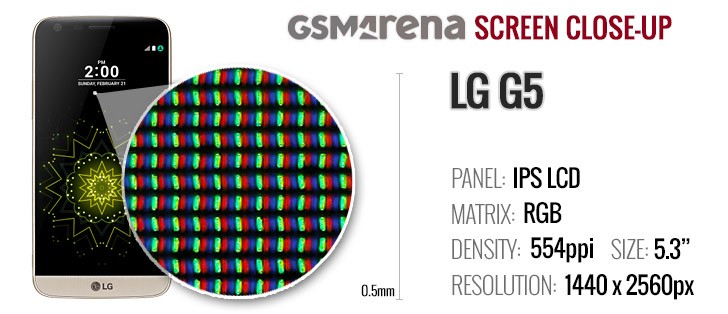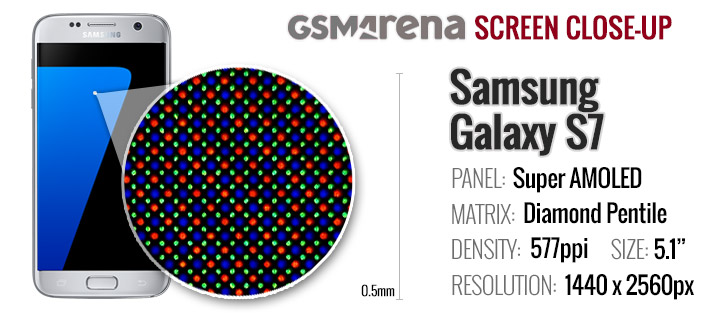LG G5 vs Samsung Galaxy S7: A rebel and a stunner
A rebel and a stunner

Display
QHD resolution is standard now, but screen size varies. Samsung settled on 5.1" for the third year in a row while LG went from 5.5" down to 5.3". When you take the on-screen buttons into account, the two will have just about the same screen real estate available to the user most of the time.
Both screens are secured by Gorilla Glass 4 so you can expect similar durability. They differ in how the 2.5D glass is shaped, but that's more of a cosmetic difference than anything else.

Both makers simultaneously launched Always On features for the screen. LG did have a preview with the LG V10, but that was a special case with a dedicated strip at the top. To be fair, Motorola did it a while ago and Nokia feature phones and Symbians had it much earlier.
The Galaxy S family is known for Super AMOLED displays and the S7 has the latest and greatest incarnation. It's very bright (especially in Auto mode) and flawless even under direct sunlight. The minimum brightness is an impressive 2.1 nits, so checking the phone in the middle of the night is no longer painful.
Color rendering is at a pro level with average deltaE of 1.7 (max is 2.3) for Basic mode. The punchier, more saturated Adaptive mode has an Avg DeltaE of 7.1.

LG has its brand of displays called Quantum (similar sounding to Sony's Quantum Dot, but not the same thing). It's an IPS LCD and it shows great improvements over LCDs of a couple of years back. It's not that bright, but contrast is incredible. It helps that black levels are nothing short of amazing at 0.17-0.2 nits.
Sunlight legibility is better than most LCDs. LG's Assertive Display adjusts pixel colors in real time to improve readability in direct sunlight (it selectively brightens dark areas of the image). In the opposite scenario - pitch black - the screen can go as low as 3.6 nits.
Color accuracy is good (average deltaE of 5.3) though not as good as a calibrated display. There are no screen modes to adjust the image settings like on the Galaxy.
| Display test | 100% brightness | ||
| Black, cd/m2 | White, cd/m2 | ||
| 0.17 | 306 | 1855 | |
| 0.20 | 378 | 1881 | |
| 0.00 | 391 | ∞ | |
| 0.00 | 563 | ∞ | |
Sunlight contrast ratio
-
Samsung Galaxy S6 edge+
4.615 -
Samsung Galaxy S7 edge
4.439 -
Samsung Galaxy S7
4.376 -
HTC One A9
4.274 -
Samsung Galaxy A3
4.241 -
Samsung Galaxy S6 edge
4.124 -
Samsung Galaxy Note5
4.09 -
Huawei Nexus 6P
4.019 -
OnePlus X
3.983 -
Oppo R7s
3.964 -
Samsung Galaxy A7 (2016)
3.918 -
Samsung Galaxy A5
3.895 -
Samsung Galaxy J7 outdoor
3.879 -
Samsung Galaxy J2 outdoor
3.873 -
Samsung Galaxy A8
3.859 -
Apple iPhone 6
3.838 -
Microsoft Lumia 950XL
3.837 -
Samsung Galaxy A9 (2016)
3.817 -
Motorola Moto X (2014)
3.816 -
Samsung Galaxy A5 (2016)
3.789 -
Apple iPhone 6s
3.783 -
Meizu Pro 5
3.781 -
Microsoft Lumia 650
3.772 -
Oppo F1 Plus
3.709 -
Vivo X5Pro
3.706 -
Apple iPhone SE
3.681 -
Samsung Galaxy A7
3.679 -
BlackBerry Priv
3.645 -
Apple iPhone 6s Plus
3.53 -
Acer Jade Primo
3.521 -
Microsoft Lumia 950
3.512 -
Oppo R7 Plus
3.499 -
Samsung Galaxy J7
3.422 -
Meizu MX5
3.416 -
Oppo R7
3.32 -
Samsung Galaxy J2
3.235 -
Motorola Moto X Play
3.222 -
Huawei P9
3.195 -
Lenovo Vibe Shot
3.113 -
LG Nexus 5X
3.092 -
Huawei Mate S
3.073 -
Microsoft Lumia 640 XL
3.065 -
Apple iPhone 6 Plus
3.023 -
Samsung Galaxy Note
2.97 -
Huawei Mate 8
2.949 -
LG G5
2.905 -
HTC One S
2.901 -
Sony Xperia Z5
2.876 -
Microsoft Lumia 550
2.851 -
Sony Xperia Z5 compact
2.784 -
LG V10
2.744 -
Xiaomi Redmi 3
2.735 -
Sony Xperia M5
2.69 -
Xiaomi Mi 4i
2.641 -
Xiaomi Mi 4c
2.574 -
Microsoft Lumia 640
2.563 -
Oppo F1
2.528 -
Sony Xperia Z5 Premium
2.525 -
HTC One
2.504 -
Sony Xperia M4 Aqua
2.503 -
Motorola Moto G
2.477 -
Lenovo Vibe K5 Plus
2.473 -
Huawei G8
2.471 -
Sony Xperia Z
2.462 -
Huawei Honor 7
2.406 -
ZUK Z1 by Lenovo
2.382 -
HTC One E9+
2.305 -
Alcatel One Touch Hero
2.272 -
Lenovo Vibe K4 Note
2.254 -
Sony Xperia C5 Ultra
2.253 -
Xiaomi Redmi Note 3 (MediaTek)
2.249 -
Sony Xperia C4 Dual
2.235 -
Motorola Moto G (2014)
2.233 -
LG Nexus 5
2.228 -
Huawei P8
2.196 -
Xiaomi Redmi Note 2
2.166 -
OnePlus Two
2.165 -
HTC One X
2.158 -
LG Aka
2.145 -
Archos 50 Diamond
2.134 -
Xiaomi Redmi Note
2.119 -
Huawei P8lite
2.078 -
Moto G 3rd gen max manual
2.026 -
Sony Xperia E4g
1.972 -
OnePlus One
1.961 -
BlackBerry Leap
1.892 -
Meizu m2 note
1.892 -
HTC Butterfly
1.873 -
ZTE Nubia Z9 mini
1.759 -
Sony Xperia U
1.758 -
Asus Zenfone Selfie
1.68 -
Motorola Moto E (2nd Gen)
1.675 -
ZTE Nubia Z9
1.659 -
Motorola Moto E
1.545 -
Sony Xperia M
1.473 -
Xiaomi Redmi 2
1.311 -
Sony Xperia C
1.283 -
Meizu MX
1.221
With smartwatches taking over a lot of the passive notification duties (discretely vibrating and letting you peek at a notification), Always On displays are what's needed to keep smartphones in the game.
Both displays show a dim clock and date, plus notifications. LG is more flexible as it also allows app notifications while the Samsung shows only missed calls and texts (so no Facebook/WhatsApp/Viber). That limits the convenience of the feature quite a bit. Another important note is that Samsung's Always On screen is brighter and more legible than LG's which is ghostly faint.

The big issue with Always On is power draw - LG claims 0.8% battery charge per hour, the Samsung uses more at 1%/h (and that's 1% of a bigger battery too). Enabling Always On puts both phones at about 50 hours of Endurance, with the Galaxy taking the bigger hit (but it's also got the brigher display).
Innovation: We predict that in a few years most phones will have a version of an Always On screen. It could be wishful thinking, but it was always a case of battery drain (the Moto X had it bad) and we're almost there. Samsung's version is brighter, more legible, but LG's shows more.
Refinement: Cudos to both makers. Super AMOLED is hands-down better than LCD in practically every way. That said, Quantum Display is among the best LCDs we've seen yet.
Winner: Samsung Galaxy S7. The screen is brighter, has more accurate colors and better sunlight legibility, a decisive win. The brighter Always On screen makes a difference too, but we wish Samsung issued an update to allow third-party notifications to show.
Battery
When designers take over product development, we get thin, lovely phones but, honestly, most of the time we just want solid battery life so we're okay with a chunkier phone if it means better battery life.
Surprisingly, Samsung seems to have heard consumers and the Galaxy S7 is thicker than the S6 (7.8mm vs. 6.8mm) and offers more battery capacity - 3,000mAh vs. 2.550mAh. There's the added bonus of leveling off the back (be gone, camera bump!).
LG went the other way and made the phone thinner (7.7mm, down from G4's thickest point at 9.8mm), but reduced battery capacity - from 3,000mAh to 2,800mAh. We guess the modular system ate up some of the internal volume, but still the G5 is both taller and wider than the S7.
Note that we ran the battery life test on the Exynos 8890 version of the Galaxy S7, but there's also a Snapdragon 820 version (same chipset that powers the LG G5).
The Galaxy S7 beats its opponent in essentially all tests. You get 5 hours more of calls, 2h extra for web browsing or 4 and a half hours of watching videos (or some combination of those three). The Endurance rating comes out an impressive 80 hours, but that's slashed to just 49 hours with Always On.

The LG G5 does pretty well on average, it's the 7 hours 30 minutes of web browsing that are a letdown. You may be thinking "that's plenty" (and it is), but it is below average. The Endurance rating is also average - 60 hours - but the good news is that the Always On screen drops that by just 10 hours (so it actually edges out the Galaxy by an hour).

Both phones ship with quick chargers. The LG G5 has version 3.0 and that puts a whopping 83% of charge (starting at 0%) in the battery in just half an hour. Samsung still uses v2.0 and that's good for 60% in 30 minutes (to be fair, it has a slightly bigger battery to fill).
Samsung is pushing for advanced wireless charging and the Galaxy S7 comes equipped with a fast version of it. Samsung hasn't disclosed the exact numbers but says it's 40% faster than first-gen wireless charging. It also supports both Qi and PMA standards (most venues offer just one standard, but supporting two makes it more likely your S7 will work).
Innovation: Fast wireless charging is a great way to go forward. Samsung, in particular, doesn't think wired connections are long for this world, as evidenced by the cut-down microUSB 2.0. LG pioneered shaped batteries that fill every nook and cranny of a phone's interior, but there's none of that in the G5.
Refinement: "More" is a good enough refinement, if you ask us. We're glad Samsung put its practical hat back on after wearing the creative beret last year.
Winner: Samsung Galaxy S7. While going by Endurance rating, both phones last the same with Always On screens on, heavier users will get more life out of the S7 (since less time will be spent in standby). Without Always On, it's a clear victory for the Galaxy.
Reader comments
- Ukrainian jew
- 29 Jan 2020
- 4XR
U and ur sis might be bit different and different in how u drop ur phones and where they happen to land along with other circumstances not to mention ur downloading different apps or some in particular are messing up her phone making even to go in fo...
- Jik47
- 13 Jan 2020
- EHi
The non removable battery is a horrible feature! On my previous S5 I was able to buy and replace the battery vs. paying a technician to replace the battery at 2-3 times the expense of me buying a battery and putting it in myself.
- eddie
- 09 Nov 2017
- NiB
I remember "Non-removable battery" was listed in "cons" for phones a few years ago...nowadays it seems like most manufacturers have non-removable battery phones and people just go along with it...it's not right...IMHO.